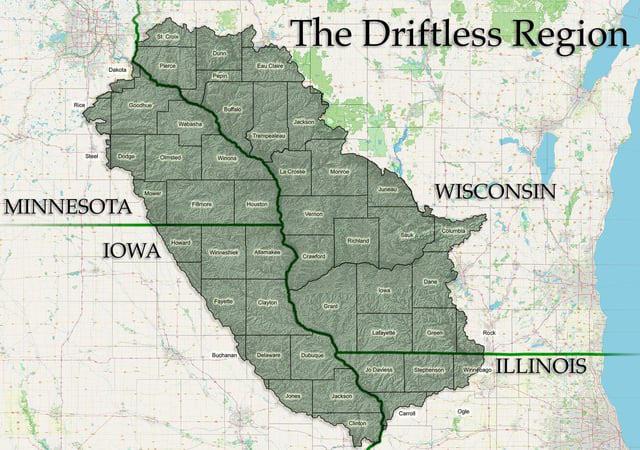Driftless Area Geographical Features Map


David Chen
Data Visualization Specialist
David Chen is an expert in transforming complex geographic datasets into compelling visual narratives. He combines his background in computer science ...
Geographic Analysis
What This Map Shows
The "Driftless Area Geographical Features Map" highlights a unique geological and ecological region in the Midwestern United States, specifically encompassing parts of Wisconsin, Minnesota, Iowa, and Illinois. This map illustrates the topographical features that make the Driftless Area distinctive compared to its surrounding regions. Unlike much of the Midwest, which was shaped by glaciers during the last Ice Age, the Driftless Area remained untouched, resulting in a landscape characterized by steep hills, deep valleys, and a network of rivers and streams that carve through the terrain.
Deep Dive into the Driftless Area's Geography
The Driftless Area is a geological anomaly that stands out due to its unique development over millions of years. Ever wondered why this region is called 'driftless'? It’s because it was never covered by glacial drift, which is a layer of sediment and debris left behind by glaciers. As a result, the land here features rugged terrain, including limestone bluffs, deep river valleys, and a rich tapestry of biodiversity.
What's fascinating is that the region's topography has been shaped primarily by erosion. The Mississippi River and its tributaries have carved out the landscape, creating steep hillsides and picturesque valleys. For example, the Kickapoo River is known for its meandering twists and turns, offering not only stunning views but also rich ecosystems that support various flora and fauna. The presence of karst topography—characterized by sinkholes, caves, and underground rivers—adds another layer of intrigue to the Driftless Area.
In terms of biodiversity, the Driftless Area is home to numerous endangered species, including the Iowa Pleistocene Snail and various species of mussels. The region also boasts an impressive array of plant life, with over 1,000 species of vascular plants documented. The contrasting elevations and varied microclimates create niches that foster this incredible diversity.
Additionally, the Driftless Area has a significant agricultural component, despite its challenging terrain. Farmers have adapted to the landscape, cultivating crops and raising livestock in ways that minimize erosion and maximize productivity. This adaptation has been vital for the local economy, which is heavily reliant on agriculture and tourism. Interestingly, the area's natural beauty has led to a rise in ecotourism, drawing visitors for hiking, fishing, and exploring the vast network of state parks and natural reserves.
Regional Analysis
When examining the Driftless Area closely, different regions within it present unique characteristics. For instance, the southwestern portion, particularly in Wisconsin, features dramatic bluffs along the Mississippi River, such as those found in the towns of Prairie du Chien and La Crosse. This area is known for its scenic overlooks and vibrant communities that capitalize on both agriculture and tourism.
Conversely, in Iowa, the terrain becomes slightly more subdued, with rolling hills and an expansive agricultural landscape dominated by corn and soybeans. Yet, even here, the interaction between the landscape and farming practices highlights the challenges and adaptations that define life in the Driftless Area.
In Minnesota, the rugged terrain gives way to expansive forests and state parks, such as the Effigy Mounds National Monument, which protects ancient burial mounds built by Native American cultures. These mounds are not only significant historical sites but also contribute to the ecological richness of the region.
Significance and Impact
Understanding the Driftless Area's geography is essential not just for appreciating its natural beauty but also for recognizing the complex interplay between human activity and the environment. The region’s unique geological history has implications for conservation efforts, particularly as climate change poses new challenges. Protecting the Driftless Area’s ecosystems is crucial for maintaining its biodiversity, which is often threatened by agricultural expansion and urban development.
As we look to the future, trends in ecotourism and sustainable agriculture could play pivotal roles in preserving the Driftless Area. Communities are increasingly aware of the need to balance economic growth with environmental stewardship. Have you noticed that more people are drawn to outdoor activities like kayaking on the Kickapoo River or hiking in the scenic bluffs? This shift in interest could lead to a renewed focus on conservation efforts and sustainable practices that honor the unique landscape of the Driftless Area.
The Driftless Area is not just a beautiful place; it is a living testament to the power of geological processes and human adaptation. By exploring its features, we can gain insights into environmental conservation, the importance of biodiversity, and the intricate relationships between people and the land they inhabit.
Visualization Details
- Published
- October 4, 2025
- Views
- 44
Comments
Loading comments...